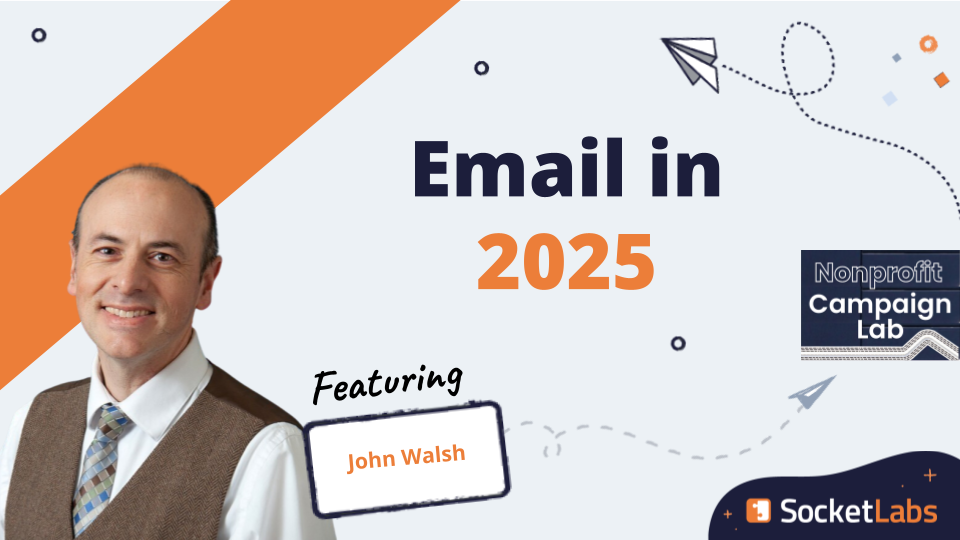
Please welcome John Walsh!
John Walsh is a digital engagement specialist who has helped raise over $20 million for nonprofits. He is the founder of Nonprofit Campaign Lab, a resource dedicated to helping nonprofits communicate and fundraise. When not building emails, he enjoys building LEGO sets, with or without his kids.
John has an email niche and it’s a very special one: nonprofit marketing. These organizations rely heavily on email to appeal to new, existing, and past donors and without a good strategy, fundraising can be at serious risk. He foresees some good changes on the horizon for 2025, but the real gold in his answers is how he blends technology with principles to lead to meaningful results.
How do you see email fitting into the marketing mix in 2025?
In 2025, email will work hand-in-hand as part of an omnichannel approach not only as a marketing and fundraising tool but as a solid way to build relationships.
Gone will be the days when channels work independently of each other. Instead, email, text, direct mail, etc. will work together for the betterment of the mission and supporters.
Email communication will continue to play a vital role in the donor experience from acquisition to cultivation, to recurring donations.
Email will have a place at each stop along the way, as will all the other channels. Together they will provide a seamless, frictionless – dare I say it – enjoyable experience.
For this experience to happen, emails will go beyond first-name personalization and use hyper-personalization. Hyper-personalization is more than pre-determined segmentation. It’s about using supporter data in real-time, through AI and predictive analysis, to personalize and customize. Hyper-personalization in the email will help you build trust and convert more often.
With hyper-personalization organizations will provide better value for their supporters. Supporters will get emails, texts, and mailings that speak to them and their interests. When supporters feel valued, they will respond in kind with donations, signing petitions, volunteering, and even fundraising for you.
What about email do you see as a nice-to-have for now, but feel will be considered table stakes by 2025?
Email automation. We already understand the value automation brings to any email marketing or fundraising program. Automation is one of those pie-in-the-sky dreams, that would make life easier and better for supporters. According to a
report 55% of marketers use automation in email marketing. This number has gone up compared to last year. This is why in a few years nonprofits must have a comprehensive automation program.
For years, organizations have dabbled with automation. Some organizations have an automated email welcome series for first-time donors. Other organizations have autoresponders to thank supporters or to let them know their credit cards will expire.
Automation is piecemeal for many organizations but by 2025, this won’t be enough. To succeed, nonprofits will need to use automation to its fullest capabilities and at every level. Organizations can use automation to send personalized emails but also use it to clean their email lists, to compile and send reports, and even to test.
Organizations implementing automation for every aspect of their marketing and fundraising will see exponential growth and engagement. Automation will free up time to analyze reports and create new strategies. Nonprofits will tweak their strategies much quicker. They will not only pivot faster but in better directions.
Automation is a tool. When integrated and used as part of the marketing plan, automation will yield faster and better results. Nonprofits that haven’t started using automation or use it only in certain areas will find themselves lagging behind. The organizations that dive all in with automation will reap the rewards.
What do you hope or wish to see change within email by 2025?
By 2025, I expect to see a wider acceptance and usage of interactive, dynamic emails. Are interactive emails possible now? Yes. But not enough email service providers allow for them and not enough organizations use them.
One question I hear over and over is, “Can we embed videos in our emails?” While the technical answer is yes, for the majority of your audience it won’t matter because the video won’t play in the email. The file size is also a concern but by 2025 all these issues will get fixed. Supporters will open an email and watch a video without the need to go to a landing page or YouTube.
Email interaction won’t stop with embedded video, either. Emails allowing supporters to take action on the email rather than on a landing page will be commonplace in a couple of years. Like the embedded video, this technology is available now (check out AMP for Email), but it is not available for most email platforms and devices.
I often talk about the importance of providing a frictionless experience for supporters. I can’t wait for the day supporters will open an email, click the button to give, and not get redirected to a different landing page. Supporters will take every step without leaving the email. This doesn’t stop at fundraising emails; organizations can have supporters fill out surveys, register for events, or download resources all from the email.
Interactive emails will increase engagement, including conversions, providing a better experience for everyone. Oh, what a wonderful email world that will be.








